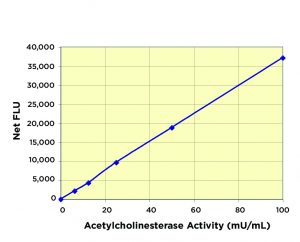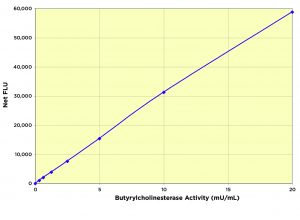Cholinesterases: Neurotransmitter Control Systems
The cholinesterase family of enzymes hold important roles in a variety of bodily functions. Acetylcholine esterase (Acetylcholinesterase, AChE) is critical for CNS functions, whereas butyrylcholine esterase (Butyrylcholinesterase, BChE) is a nonspecific cholinesterase enzyme that hydrolyzes many different choline-based esters.
The use of AChE inhibitors as therapeutic agents and pesticides has spurred detailed investigations of cholinesterases after the initial physical characterization of the enzyme by Leuzinger in the late 1960’s (2). Acetylcholine (ACh) is an essential neurotransmitter in the central and peripheral nervous systems. In the brain, multiple areas exist where cholinergic neurons are concentrated (3). Nicotinic and muscarinic ACh receptors are recognized as binding and effector proteins to mediate chemical neurotransmission at neurons, ganglia, heart and smooth muscle fibers and glands. This traditional view of ACh acting only as a neurotransmitter has been revised based on findings which demonstrate the non-neuronal cholinergic system published both early and late last century.
Impairment of cholinergic neurotransmission is well-established in Alzheimer’s disease, despite questions about its relevance at the early stages of the disease and in mild cognitive impairment. In vivo positron emission tomography imaging of cortical AChE activity as a marker of cholinergic function has demonstrated a reduction in this enzyme’s activity in manifest Alzheimer’s patients (4). As dementia advances in Alzheimer’s disease, an increase in the activity of Butyrylcholinesterase (BChE) and decrease in the activity of AChE allows the use of BChE activity as a biomarker for progression (9), or a target for future therapies.
Other intentional or environmental impairment may occur with organophosphates and carbamates with anticholinergic properties, which are used as insecticides or warfare agents. Thousands of cases of acute poisoning have been reported (5). This acute toxicity inhibits AChE at nerve terminals causing accumulation of Acetylcholine. This, in turn, induces over-stimulation of nicotinic and muscarinic receptors in the central and peripheral nervous systems and the consequent signs and symptoms (6).
BChE is a 440kDa tetrameric glycoprotein predominantly found in blood, kidneys, intestine, liver, lung, heart and the central nervous system. The human body has more than ten times more butyrylcholinesterase than acetylcholinesterase. BChE, or its mRNA, is found in almost every source, including plasma, liver, brain, muscle, saliva, kidney, heart, lining of blood vessels, skin, colon, small intestine, spleen, and lung (1). Many species, including human, horse and mice, exhibit high BChE activity in plasma, whereas rats have higher acetylcholinesterase activity in plasma (7). A deficiency of BChE can result in the delayed metabolism of cocaine and other drugs, and treatment with doses of BChE can help overcome the physiological reaction to them (8). As an activator enzyme, BChE converts administered prodrugs into functional therapeutics. Bambuterol is a prodrug with anti-asthmatic properties once converted by BChE. BChE is the only enzyme in human serum that acts on heroin and its end product. After crossing the blood-brain barrier, heroin is hydrolyzed to morphine by enzymes in the brain. The Arbor Assays DetectX® AChE and BChE Fluorescent Activity Assays utilize human native AChE and BChE standards, and measure enzyme activity in serum, plasma, RBC membranes, and CSF samples. Both kits use s-alkylated thiocholine substrates to generate thiocholine from the respective enzymes, which then immediately reacts with our simple, stable ThioStar® thiol-reactive molecule to generate a highly fluorescent product from the non-fluorescent starting molecule. The resulting signal can be read as an end point or kinetically with a broad emission spectrum centered at 510 nm. Both assays are the most sensitive and easy-to-use kits available.
1) Manoharan I, Boopathy R, Darvesh S, Lockridge O., “A medical health report on individuals with silent butyrylcholinesterase in the Vysya community of India” Clin Chim Acta 2007;378:128–135.
2) Leuzinger,W., “Acetylcholinesterase (Electrophorus electricus)“. Meth. Enzymol., XVIIB, (Tabor, H., and Tabor, C. Eds) 1971, Academic Press 782.
3) Perry E, Walker M, Grace J, Perry R. “Acetylcholine in mind: a neurotransmitter correlate of consciousness?” Trends Neurosci. 1999; 22:273–280.
4) Herholz, K., “Acetylcholine esterase activity in mild cognitive impairment and Alzheimer’s disease.” Eur J Nucl Med Mol Imaging 2008; 35(Suppl 1):S25-S29.
5) Moretto, A and Lotti, M., “Toxicity of pesticides.” In: Stacey, N.H. Ed.., Occupational Toxicology. Taylor and Francis, London, pp. 177-204.
6) Lotti, M. “Treatment of acute organophosphate poisoning.” Med. J. Aust. 1991; 154: 51-555.
7) Cokugras, AN. “Butyrylcholinesterase: Structure and Physiological Importance.” Turk J Biochem 2003; 28(2): 54-61.
8) Carmona GN, et al., “Butyrylcholinesterase accelerates cocaine metabolism: in vitro and in vivo effects in nonhuman primates and humans.” Drug Metabolism and Disposition 1999; 28(3): 367-71.
9) Lane RM, et al., “Targeting Acetylcholinesterase and Butyrylcholinesterase in Dementia.” Int J Neuropsychopharmacol 2006.



